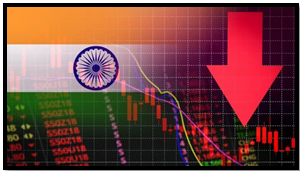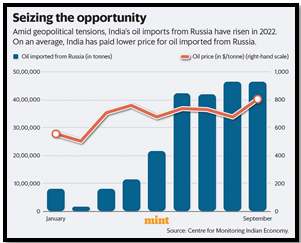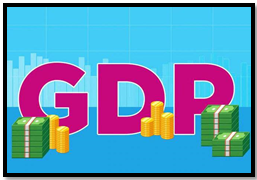CALIBRATING A STRATEGY FOR INDIAS FUTURE GROWTH
Relevance:
GS 1
- Indian Economy and issues relating to planning, mobilization, of resources, growth, development and employment.
- Inclusive growth and issues arising from it.
Why in News:
- India’s growth in 2023-24 is currently projected by the Reserve Bank of India at 7%
Source- National
India’s growth forecast for 2023-24 varies, with the RBI estimating 7%, while the IMF and World Bank peg it at 6.3%. Despite India’s promising growth rates of 7.8% and 7.6% in the first two quarters of the fiscal year, the global landscape’s volatility demands a nuanced approach.
Current Growth Scenario
- Projected Growth Rates: RBI forecasts 7%, IMF and World Bank estimate 6.3% growth for 2023-24.
- Historical Trends: Fluctuations in export shares and shifts in economic drivers highlight a need for a revised growth approach.
- Deglobalization Concerns: Ongoing geopolitical conflicts lead to supply chain disruptions, impacting global GDP growth and reducing export demands.
Global Dynamics: Impact on India’s Growth
- Deglobalization Trends: The world witnesses shifts towards protectionism and fractured trade alliances, impacting supply chains and global demand.
- Geopolitical Unrest: Conflicts like the Russia-Ukraine war and the Israel-Hamas tensions disrupt international settlements, affecting trade and economic stability.
Reducing External Dependencies
- Petroleum Diversification: India, along with other nations, seeks to minimize reliance on imported petroleum due to price volatility and geopolitical uncertainties.
- Revising Export Strategy: A historical peak of 25% in 2013-14 and subsequent declines to 18.7% in 2019-20 suggest the need to redefine India’s export-led growth strategy.
Source: The Mint
Savings, Investment, and Employment Challenges
- Savings Decline: The drop in household sector savings post-COVID-19, particularly in financial assets, poses a risk to available resources for investment.
- Boosting Investment Rates: Increasing domestic savings becomes pivotal, with nominal investment rates hovering around 29.2%, necessitating a push to achieve higher real investment rates for sustained growth.
- Employment Amidst Technological Progress: As labor-saving innovations rise, India faces the challenge of skilling its workforce to align with evolving technological demands.
Technological Integration and Climate Commitments
- Technological Adaptation: India must embrace AI and other productivity-enhancing technologies to optimize growth while balancing job creation.
- Climate Imperatives: Commitments to reduce carbon emissions by a billion tonnes between 2021-2030 and achieving net-zero emissions by 2070 demand eco-friendly technological transitions and initiatives like electric vehicles and renewable fuels.
Fiscal Prudence and Economic Stability
- Fiscal Targets: The necessity to adhere to fiscal responsibility targets to maintain economic stability, emphasizing the reduction of fiscal deficits and debt-to-GDP ratios.
- Interest Management: Keeping interest payments manageable by achieving a balance or surplus on government revenue accounts becomes crucial.
Medium-Term Growth Outlook
- Projected Growth: Expectations of a 6.5% growth rate in the next two years, subject to both domestic and external factors.
- Key Focus Areas: Emphasizing savings, investment, skill development, technology-friendly policies, and climate-conscious initiatives are critical to achieving a sustained growth rate of 7% to 7.5%.
India’s growth narrative is evolving amidst a complex global landscape. To thrive, it requires a multi-dimensional strategy:
- Domestic Focus: Prioritizing domestic drivers over reliance on external factors to sustain growth momentum.
- Economic Resilience: Navigating geopolitical tensions and deglobalization by fortifying domestic capabilities.
- Investment Thrust: Increasing domestic savings, fostering an investment-friendly environment, and skilling the workforce to meet the demands of evolving technologies.
- Environmental Consciousness: Aligning growth objectives with climate commitments by adopting eco-friendly technologies and sustainable practices.
- Fiscal Discipline: Adhering to fiscal responsibility targets to maintain economic stability and prevent overreliance on debt financing.
In essence, India’s journey toward sustained growth at a rate of 7% to 7.5% demands strategic recalibration across economic, technological, and environmental fronts. Prioritizing domestic resilience while staying responsive to global shifts will be pivotal in shaping India’s future growth trajectory.
| Gross Domestic Product, commonly known as GDP, quantifies the aggregate worth of all end-stage products and services generated within the territorial boundaries of a nation during a defined timeframe. GDP serves as a key metric for gauging a country’s economic performance and its overall well-being.
Formula For Calculating GDP GDP = C + I + G + IX where, C = Consumption (Expenditure by households on goods and services) I = Investment (Spending by businesses on capital goods like machinery, buildings, and technology) G = Government Expenditure (Expenditure by the government on public services and infrastructure) IX = Export – Import (The difference between exports and imports) Calculating GDP · India calculates its GDP using two distinct methodologies, which yield similar but not identical results. The first method is based on economic activity at factor cost, while the second is based on expenditure at market prices. These methods lead to the computation of nominal GDP (using current market prices) and real GDP (adjusted for inflation). Among these figures, GDP at factor cost is the most commonly observed and reported.
Types of Gross Domestic Product 1. Real GDP · Real GDP represents the total value of all goods and services produced by an economy in a specific year, expressed in prices from a chosen base year which is 2011 for India. It is also referred to as constant-price GDP or inflation-corrected GDP. 2. Nominal GDP · Nominal GDP measures a country’s economic output while considering current market prices. Unlike real GDP, it does not account for inflation or changes in price levels, which can potentially overstate the growth rate. All products and services in nominal GDP are valued at the prices at which they were sold during the reporting year. 3. GDP Per Capita · GDP per capita is a metric that quantifies the GDP on a per-person basis within a country’s population. It provides insights into the average productivity or living standards in an economy. There are three variations of GDP per capita: nominal, real (inflation-adjusted), and purchasing power parity (PPP) GDP per capita. 4. GDP Purchasing Power Parity (PPP) · Although not a direct GDP measure, purchasing power parity (PPP) is used by economists to compare one country’s GDP to others in “international dollars.” This comparison adjusts for differences in local prices and the cost of living, enabling cross-country assessments of real output, income, and living standards. |
Source
The Hindu
Mains Question
“Assessing India’s Growth Trajectory: What Strategic Frameworks Are Essential to Achieve Sustainable 7% to 7.5% Economic Growth Amidst Global Volatility, Technological Advancements, and Climate Imperatives?”

 Source- National
Source- National Source: The Mint
Source: The Mint Source: Taxcorps
Source: Taxcorps

